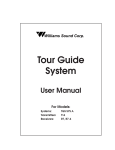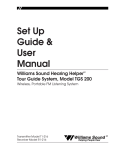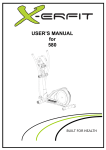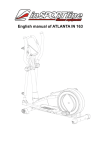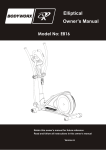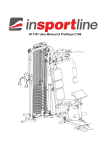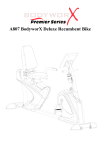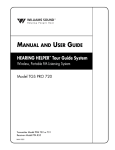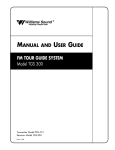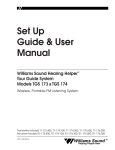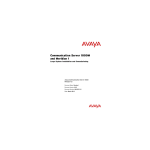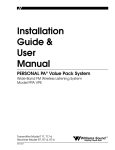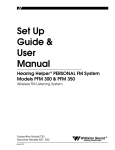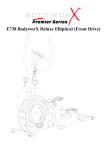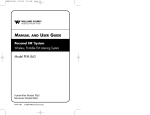Download Williams Sound TGS SYS A User guide
Transcript
® Williams Sound Helping People Hear MANUAL AND USER GUIDE FM TOUR GUIDE SYSTEM, 72-76 MHz Model TGS SYS A Transmitter Model PPA T16 Optional Receiver Models PPA R7, PPA R7-4 MAN 015H FM TOUR GUIDE SYSTEM, MODEL TGS SYS A INSTALLATION GUIDE & USER MANUAL Contents Page System Overview 3 System Components 4 PPA T16 Transmitter Microphones PPA R7 Receiver Headphones & Earphones Safety Information 6 Recycling Instructions 6 Operating Instructions 7 PPA T16 Transmitter PPA R7 Receiver Hints for Using the System Battery Information 12 Battery Installation Rechargeable & Non-rechargeable Batteries Using Optional Battery Chargers 2 In Case Of Difficulty 14 Warranty 15 System Specifications 16 Williams Sound ® Helping People Hear SYSTEM OVERVIEW The FM Tour Guide System is a portable, high-performance, wireless system composed of the PPA T16 Transmitter and PPA R7 Receivers and designed for use in guided tour applications. The system allows one-way transmission of a tour guide’s voice to group members using an FM radio signal. Using the system helps group members overcome background noise and distance from the person speaking. The FM System can be used for large or small tour groups and in noisy or quiet environments. Your FM Tour Guide System has two principal parts: the transmitter and the receiver. Much like a miniature radio station, the transmitter and microphone pick up the sounds you want to hear and broadcast them over an FM radio signal. The receivers and headphones are used to pick up the broadcast up to 100 meters away. To avoid difficulties, please read through these instructions as you begin to use the system. Then save them for questions that arise as you continue to use your system. If you have problems with the FM Tour Guide System, don’t hesitate to call Williams Sound at 1-800-843-3544. FM Radio Signal Tour Guide Uses the Body Pack Transmitter With Microphone Listeners use Personal Receivers with Earphones, Headphones, Or Neckloop The tour guide wears the body-pack transmitter and headset microphone. The guide’s voice is broadcast as an FM radio signal over a distance of up to 100 meters. Listeners use the pocket receiver and headphone to hear the speaker’s voice directly, with reduced background noise. A neckloop telecoil coupler allows the system to be used with telecoil (T-Switch) equipped hearing aids, at somewhat reduced range. Williams Sound ® Helping People Hear 3 SYSTEM COMPONENTS þ Body Pack Transmitter (PPA T16) with 9 Volt, Alkaline disposable battery (BAT 006) þ Noise-cancelling headband microphone (MIC 086) þ (6) Personal FM Receivers (PPA R7) with 9 Volt, Alkaline disposable battery (BAT 006) and headphones (HED 021) þ Belt clip cases (CCS 001) þ Instruction Manual þ System carry case (CCS 030 S) THE PPA T16 TRANSMITTER The T16 Transmitter is a battery-powered belt pack that is used with a microphone to pick up the tour guide's voice. The Transmitter produces an FM radio signal to broadcast the tour guide's voice to the receiver units. A simple slide switch on top of the transmitter turns the unit on or off. The T16 operates on a 9 Volt alkaline disposable battery (BAT 006) or a 9V NiMH rechargeable battery (BAT 003). MICROPHONES A noise-cancelling, headband microphone (MIC 086) is the standard microphone. The noise-cancelling microphone helps to reduce background sounds in noisy environments. The microphone plugs into the “MIC” jack on top of the Transmitter. The microphone should be positioned directly in front of the tour guide's mouth to achieve an optimal signal to noise ratio and so that head movement does not affect the loudness of the signal. The microphone cord acts as the transmitting antenna. OPTIONAL MICROPHONES An optional Hearing Protector Headset Microphone (MIC 036) is also available for extremely high noise environments. It features ear muffs that completely cover both ears and provides 24 dB noise isolation for hearing protection. An optional Lapel Clip Microphone can be used in quieter environments like museums or galleries. The MIC 090 has an omnidirectional pick-up pattern. The MIC 056 has a directional (or cardioid) pick-up pattern, which will reduce background noise. A small hand-held microphone (MIC 026) is also available for tour guides who prefer to hold the microphone. THE PPA R7 RECEIVER The R7 Receiver is a battery-powered belt pack that is used with a headphone to hear the signal produced by the Transmitter. The Receiver is pre-tuned to the Transmitter and has a user-adjustable volume control. The headphone plugs into the "EAR/CHG" jack on top of the Receiver. The receiver is turned on by rotating the volume control wheel. The receiver operates on a 9 Volt alkaline disposable battery (BAT 006) or a 9V NiMH rechargeable battery (BAT 003). 4 Williams Sound ® Helping People Hear HEADPHONES AND EARPHONES The HED 021 Lightweight Headphone is the standard headset for the Tour Guide System. It offers excellent sound quality and wearing comfort. The foam earpads may be removed and washed in a mild detergent, rinsed thoroughly, and air dried. Replacement pads (HED 013) are available. The headphone plugs into the “EAR” jack on top of the Receiver. The headphones are wired with a mono plug. If a stereo headphone is substituted, it will only work on one side of the headphone. OPTIONAL HEADPHONES AND EARPHONES The HED 008 is a heavy-duty, hearing-protector headset. The HED 008 earmuffs completely cover the ears and provide 24 dB noise isolation for hearing protection in high noise environments. The EAR 022 Surround Earphone offers excellent sound quality in a unique style that hangs on the ear. It is easy to keep clean since the earphone does not enter the ear. It is not recommended for high noise environments. The EAR 013 and EAR 014 are single and dual Mini Earphones. The earbud-style features a foam covering that fits in the outer ear. The foam pads can be removed for cleaning or replacement. Replacement pads (EAR 015-10) are available. The stylish HED 026 rear-wear headphone offers excellent sound quality; it rests comfortably over the ears and wraps around the back of the head for a less obtrusive, relaxed fit. EARPHONE / HEADPHONE OPTIONS R HED 008 Williams Sound ® Helping People Hear HED 021 HED 026 EAR 022 EAR 013 EAR 014 5 SAFETY INFORMATION HEARING SAFETY CAUTION! This product is designed to amplify sounds to a high volume level which could potentially cause hearing damage if used improperly. To protect your hearing and the hearing of others: 1. Make sure the volume is turned down before putting on the earphone or headphone before adjusting the volume to a comfortable level. 2. Set the volume level at the minimum setting that you need to hear. 3. If you experience feedback (a squealing or howling sound), reduce the volume setting and move the microphone away from the earphone or headphone. 4. Do not allow children or other unauthorized persons to have access to this product. BATTERY SAFETY AND DISPOSAL CAUTION! This product is supplied with disposable Alkaline batteries. Do not attempt to recharge disposable batteries, which may explode, release dangerous chemicals, cause burns, or other serious harm to the user or product. PACEMAKER SAFETY: CAUTION! 1. Before using this product with a pacemaker or other medical device, consult your physician or the manufacturer of your pacemaker or other medical device. 2. If you have a pacemaker or other medical device, make sure that you are using this product in accordance with safety guidelines established by your physician or the pacemaker manufacturer. RECYCLING INSTRUCTIONS BATTERY SAFETY AND DISPOSAL Help Williams Sound protect the environment! Please take the time to dispose of your equipment properly. Product Recycling for Customers in the European Union: Please do NOT dispose of your Williams Sound equipment in the household trash. Please take the equipment to an electronics recycling center; OR return the product to the factory for proper disposal. Battery Recycling for Customers in the European Union: Please do NOT dispose of used batteries in the household trash. Please take the batteries to a retail or community collection point for recycling. 8/31/05 6 Williams Sound ® Helping People Hear OPERATING INSTRUCTIONS USING THE PPA T16 TRANSMITTER Instructions: Before you begin, make sure you have a 9V Alkaline disposable battery (BAT 006) installed in the transmitter. See Battery Information, page 12. 1. Install the battery in the Transmitter. A 9V alkaline disposable battery (BAT 006) is included with the transmitter. If you are using a 9V rechargeable battery, see page 12. Open the battery door on the Transmitter by lifting the battery door up. A coin may be used to help open the battery door. Carefully insert the battery, observing proper polarity. The large battery terminal (-) is nearest the top of the compartment. DO NOT FORCE THE BATTERY IN BACKWARDS. DAMAGE TO THE TRANSMITTER WILL RESULT! Close the battery door by snapping it shut. If you are using a disposable battery, use only 9V alkaline disposable batteries (BAT 006). A disposable battery should last 15 hours. A BAT 003 re-chargeable battery will last about 3 hours per charge. 2. 3. Plug the microphone into the "MIC/CHG" jack on top of the Transmitter. The Headset Microphone boom should be positioned as close to the wearer's mouth as possible without actually touching. Lapel Clip microphones should be attached to a collar or lapel, as close to the wearer's mouth as possible. The Transmitter can be placed in a pants pocket or clipped onto a belt or waistband in the Belt Clip Case included with the Transmitter. Note: The microphone cord is the transmitting antenna. Do not bunch it up or wrap it around the transmitter. Allow it to hang as straight as possible. 4. Turn the Transmitter on by moving the slide switch on top of the Transmitter to "ON." To conserve battery life, there is no indicator light. Make sure you turn the Transmitter off when it is not in use to conserve the battery. T16 TRANSMITTER TOP VIEW Off Mic Mic Jack FM Williams Sound FM NOTE ON THE TRANSMITTER On On/Off Switch ON Indicator ANTENNA: The microphone cord is the transmitting antenna. Do not bunch up the cord, wrap it tightly around your body, or wrap it aroun the transmitter. For maximum range, the cord should hang as straight as possible. The transmitter can be placed in a pants pocket, or clipped onto a belt or waistband. Make sure the transmitter is turned OFF when not in use. Williams Sound ® Helping People Hear 7 T16 TRANSMITTER FREQUENCY CHANGE PROCEDURE: 1. Remove the Transmitter from the Belt Clip Case. 2. Open the battery door and remove the battery. 3. Grasp the right corner of the battery door and lift the flap up and to your left. The back of the Transmitter case will open like a book, exposing the circuit board. 4. Use the photo below to locate the channel selector switches. 5. Use the tip of a paper clip or a small screwdriver (not a pencil point) to move the switches to correspond with the switch positions on the programming chart. Select a new frequency at least two channels away from the one you are experiencing interference on. DO NOT TOUCH ANY OF THE OTHER ADJUSTMENTS! 6. Close the back of the Transmitter and install the battery. Plug the microphone in and turn the Transmitter on to provide a tuning signal for the receivers. See the next section for receiver tuning instructions. 8 Williams Sound ® Helping People Hear USING THE PPA R7 RECEIVER 1. Install the battery in the Receiver. A 9V alkaline battery (BAT 006) is included with each receiver. If you are using a rechargeable battery, see page 12. Open the battery door on the Receiver by lifting the battery door up. A coin may be used to help open the battery door. Carefully insert the battery, observing proper polarity. The large battery terminal (-) is nearest the top of the compartment. DO NOT FORCE THE BATTERY IN BACKWARDS. DAMAGE TO THE RECEIVER WILL RESULT! Close the battery door by snapping it shut. If you are using a disposable battery, you can use 9V carbon or alkaline batteries. A disposable carbon battery (Eveready 216 or equiv.) should last 15 hours. A disposable alkaline battery (Eveready 522 or equiv.) should last about 32 hours. A BAT 003 rechargeable battery will last about 6 hours per charge. 2. Plug the headphones or earphone into the "EAR/CHG" jack on top of the Receiver. 3. Turn the Receiver on by rotating the volume control wheel. Adjust the volume to a comfortable level. R7 RECEIVER TOP VIEW Headphone Jack EAR “On” Indicator LED Volume 1 INSTRUCTIONS FOR THE On/Off Volume Control R7-4 MULTI-CHANNEL RECEIVERS: The multi-channel Receivers have a rotary selector knob on top which allows the user to select any of four operating channels. The R7-4 tunes channels ACEG. These receivers are designed for use in multiple channel systems with a number of tour groups or language groups. RE-TUNING THE TOUR GUIDE SYSTEM: RADIO INTERFERENCE: The TOUR GUIDE System is usually not disturbed by other radio services, however there is no such thing as a clear or exclusive channel for ANY radio service. One of the unique features of the Williams Sound TOUR GUIDE System is that the operating frequency can easily be changed in the field to avoid interference. There are thirteen possible frequencies for tour guide use (72-76 MHz). The TOUR GUIDE System can be quickly changed to any of these frequencies by your Williams Sound Authorized Dealer. The Transmitter is changed first. Then the signal produced by the Transmitter is used to tune the receivers. Williams Sound ® Helping People Hear 9 RECEIVER FREQUENCY CHANGE INSTRUCTIONS Tuning for the R7, R30, R31, and R32 receivers is determined by a single tuning coil. In the R7-4 and R7-6, one coil is assigned to each switch position. See the following 6 figures and receiver types to locate the coils to be adjusted. A plastic tuning wrench (PLT 005) will be needed to adjust these receiver tuning coils. 1 1 2 2 IC01 TUNING COIL R30 R- 31 R-32 Ferrite Tuning "Slug" 5 1 R7Y R7- 4 2 3 4 R7- 6 1 2 3 6 4 Most Williams Sound single channel Receivers are set at the factory to 72.9 MHz. The standard four-channel receivers (R7-4NA), Channels 1-4, are usually set to frequencies 72.1, 72.5, 72.9, 75.7 MHz respectively. The standard six-channel receivers (R7-6N), channels 1-6, are set to frequencies 72.1, 72.5, 72.9, 75.7, 74.7 and 75.3 MHz respectively. The Receiver must be tuned with a weak and somewhat noisy signal. If tuned too close to the transmitter, with a strong signal, the most accurate tuning of the receiver is not possible. To Change the Frequency to Another Channel: 10 Step 1: Set the transmitter to the channel desired and remove the antenna. Step 2: Connect an audio source to the transmitter such as a CD or cassette player or microphone. Step 3: Move the receiver about 25 feet away from the transmitter to set the tuning. Step 4: Open the battery compartment, then lift up on the battery door to open the back of the receiver. This will expose the tuning coil or coils to be adjusted. Williams Sound ® Helping People Hear HINTS FOR USING THE SYSTEM Normal operating distance between the transmitter and receiver is about 30 meters. The operating range will vary in different buildings and surroundings. In some locations, the signal may momentarily disappear. This is called a “drop-out” and is due to reflection and cancellation of the radio signal. Moving a few feet will restore the signal. Keep the transmitter and receiver units at least a meter apart. If the transmitter gets too close to a receiver, it can overload the receiver, causing noisy reception or blocking of the signal. Do not use more than one transmitter on the same channel (frequency) at the same time unless they are physically separated by more than 30 meters. Operating more than one transmitter on the same channel at the same time in the same place will result in interference. USING MULTIPLE SYSTEMS FOR MULTIPLE GROUPS: For multiple tour groups within the same facility, multiple Tour Guide Systems may be operated on the same channel at the same time by maintaining physical separation of 30 meters between groups. The physical separation of groups takes advantage of the FM capture effect which causes receivers to lock onto the closest transmitter. TOUR GUIDE GROUP SEPARATION Tour Group 1 Channel A Williams Sound ® Helping People Hear 30 Meters Tour Group 2 Channel A 11 BATTERY INFORMATION INSTALLATION Open the battery compartment using a coin in the slot in the bottom of the receiver or transmitter. Press the batteries into place, observing proper battery polarity. Incorrect insertion of the battery is difficult, and if forced, may cause both mechanical and electrical damage to transmitters or receivers not covered by the five year warranty. Units will not work with the battery incorrectly installed. BATTERY INSTALLATION Rear of Receiver Battery Compartment Note Proper Polarity Tab NON-RECHARGEABLE BATTERIES In normal use, a single 9V alkaline disposable battery (BAT 006) will last about 15 hours in the PPA T16 Transmitter and approximately 32 hours in the PPA R7 Receiver. If the sound becomes weak or distorted, replace the batteries. Do not leave dead batteries in the receivers. Battery corrosion is not covered by the Williams Sound five year warranty. RECHARGEABLE BATTERIES The PPA T16 Transmitter and PPA R7 Receivers can use rechargeable 9V batteries (BAT 003). On an overnight charge, these NiMH batteries are designed to operate a PPA T16 Transmitter for approximately 3 hours, and PPA R7 Receivers for 6 hours. IMPORTANT RECHARGEABLE BATTERY INFORMATION Rechargeable batteries are shipped in a discharged condition. They must be charged for 12 - 14 hours before using them. Make sure Transmitters and Receivers are turned OFF while charging. Williams Sound products are designed for use with a rechargeable battery (BAT 003) and matching charger (BAT 005 or CHG 1269). This is the only type of rechargeable battery and charger we recommend. The BAT 003 has an 8.4 V nominal voltage and 100mAh capacity, compared to only 7.2V and 60 mAh for other types of rechargeable "9V" batteries. The BAT 003 provides significantly longer battery life per charge than lower voltage batteries. !! IMPORTANT WARNINGS !! DO NOT ATTEMPT TO RECHARGE ZINC CARBON (“HEAVY DUTY”), ALKALINE, OR LITHIUM BATTERIES! DO NOT ATTEMPT TO RECHARGE DISPOSABLE BATTERIES! These batteries may heat up and explode, causing possible injury and damage to the equipment. Avoid shorting the plus and minus battery terminals together with metal objects. Battery damage and burns can result! 12 Williams Sound ® Helping People Hear USING THE CHARGER The BAT 005 Single Charger has a cord that plugs into the receiver "EAR/CHG" jack to charge the battery. The BAT 005 Charger has snaps for direct attachment of a 9V rechargeable battery. The CHG 1269 Multiple Charger can charge 12 receivers simultaneously through the receiver "EAR" jacks. See the instructions included with the CHG 1269 for more information. The battery does not have to be removed from the receiver or transmitter for charging with the BAT 005 and CHG 1269 Chargers. Do not mix and match batteries and chargers from different manufacturers. Using the BAT 003 battery with chargers designed for lower-voltage batteries can result in under-charging and unsatisfactory battery life. Using the BAT 005 or CHG 1269 Charger with low-voltage batteries can result in over-charging and battery failure. NOTE: Do not dispose of batteries in fire. Do not open batteries - toxic chemicals inside. DO NOT attempt to recharge disposable batteries! BATTERY CHARGING INSTRUCTIONS: 1. Make sure the Transmitter or Receiver is turned OFF while it is charging. 2. To charge the battery without removing it from the Transmitter or Receiver, use the BAT 005 Charger or the CHG 1269 Multiple Charger. Plug the Charger cord into the earphone jack (labeled EAR/CHG) on a Receiver. Plug the cord into the microphone jack (MIC) on Transmitters. Then plug the Charger into an AC wall outlet. The Charger indicator light will glow while the battery is charging. Charge for 12-14 hours. DO NOT CHARGE THE BATTERIES LONGER THAN 14 HOURS. 3. To charge the battery outside the unit or to keep a spare battery charged, use the BAT 005 Charger. Remove the battery from its compartment and attach it to the snaps on the Charger. Then plug the Charger into an AC wall outlet and charge for 12-14 hours. DO NOT CHARGE THE BATTERIES LONGER THAN 14 HOURS. 4. Expected Battery Life: 6 hours per charge for a Receiver. 3 hours per charge for a Transmitter. With normal service, the BAT 003 rechargeable battery should last approximately 1 year before it will need to be replaced. Williams Sound ® Helping People Hear 13 IN CASE OF DIFFICULTY If your Tour Guide System is not working, check the following: 1. Read through the manual and user guide carefully to verify proper setup and installation of your system. 2. Make sure the batteries are fresh or completely charged and that the “plus” and “minus” terminals are installed correctly. 3. If the rechargeable batteries will only work for a short period of time (less than 1 hour) even after they are fully charged, they must be regenerated. Leave them in the receiver or transmitter with the unit turned on, for 5 - 6 hours. Then turn receiver or transmitter off, place it in the charger, and charge for 14 - 16 hours. This should restore normal battery life. Rechargeable batteries will gradually lose their capacity over time and should be replaced every year. 4. Make sure the microphone is plugged into the PPA T16 Transmitter and the headphone is plugged into the PPA R7 Receiver. 5. Move the transmitter and receiver closer together. You may be out of range. When using the system indoors, it’s normal for the signal to momentarily disappear in certain locations. This is called a “drop-out.” Moving a few feet will restore the signal. 6. Do not try to use more than one transmitter on the same channel in close proximity to each other. MORE THAN ONE TRANSMITTER ON THE SAME CHANNEL WILL RESULT IN INTERFERENCE IF THEY ARE CLOSE TOGETHER. Keep the systems at least 30 meters apart or use separate channels for each system used. 7. If you are still hearing interference on the receivers, turn the transmitter off and listen with a receiver. If you hear the interference with the transmitter off, you need to change to a clear channel. Call your Williams Sound at 1-800-843-3544 for details. 14 Williams Sound ® Helping People Hear LIMITED WARRANTY Williams Sound products are engineered, designed, and manufactured under carefully controlled conditions to provide you with many years of reliable service. Williams Sound warrants the FM Tour Guide System against defects in materials and workmanship for FIVE (5) years. During the first five years from the purchase date, we will promptly repair or replace the FM Tour Guide System. Microphones, earphones, headphones, batteries, chargers, cables, carry cases, and all other accessory products carry a 90-day warranty. WILLIAMS SOUND HAS NO CONTROL OVER THE CONDITIONS UNDER WHICH THIS PRODUCT IS USED. WILLIAMS SOUND, THEREFORE, DISCLAIMS ALL WARRANTIES NOT SET FORTH ABOVE, BOTH EXPRESS AND IMPLIED, WITH RESPECT TO THE FM TOUR GUIDE SYSTEM, INCLUDING BUT NOT LIMITED TO, ANY IMPLIED WARRANTY OF MERCHANTABILITY OR FITNESS FOR A PARTICULAR PURPOSE. WILLIAMS SOUND SHALL NOT BE LIABLE TO ANY PERSON OR ENTITY FOR ANY MEDICAL EXPENSES OR ANY DIRECT, INCIDENTAL OR CONSEQUENTIAL DAMAGES CAUSED BY ANY USE, DEFECT, FAILURE OR MALFUNCTIONING OF THE PRODUCT, WHETHER A CLAIM FOR SUCH DAMAGES IS BASED UPON WARRANTY, CONTRACT, TORT OR OTHERWISE, THE SOLE REMEDY FOR ANY DEFECT, FAILURE OR MALFUNCTION OF THE PRODUCTS REPLACEMENT OF THE PRODUCT. NO PERSON HAS ANY AUTHORITY TO BIND WILLIAMS SOUND TO ANY REPRESENTATION OR WARRANTY WITH RESPECT TO THE FM TOUR GUIDE SYSTEM. UNAUTHORIZED REPAIRS OR MODIFICATIONS WILL VOID THE WARRANTY. The exclusions and limitations set out above are not intended to, and should not be construed so as to contravene mandatory provisions of applicable law. If any part or term of this Disclaimer of Warranty is held to be illegal, unenforceable, or in conflict with applicable law by a court of competent jurisdiction, the validity of the remaining portions of this Disclaimer of Warranty shall not be affected, and all rights and obligations shall be construed and enforced as if this Limited Warranty did not contain the particular part or term held to be invalid. If you experience difficulty with your system, call Toll-Free for Customer Assistance: 1-800-843-3544 If it is necessary to return the system for service, your Customer Service Representative will give you a Return Authorization Number (RA) and shipping instruction. Pack the system carefully and send it to: Williams Sound Corp. Attn: Repair Dept. 10321 West 70th Street Eden Prairie, MN 55344 USA Your warranty becomes effective the date you purchase your system. Your returned warranty card is our way of knowing when your warranty begins. It also gives us important information about your system including the serial number. This information will help us serve you better in the future. Please take a moment to complete and mail the attached card. Thank you. Williams Sound ® Helping People Hear 15 FM TOUR GUIDE SYSTEM SPECIFICATIONS PERSONAL PA TRANSMITTER, MODEL T16 Dimensions: Weight: Color and Material: 3-5/8" L x 2-3/8" W x 7/8" H (92.1mm x 60.3 mm x 22.2 mm) 3.2 oz (90 g) with 9V battery Gray, polyallomer Battery Type: 9 Volt, Eveready 522 Alkaline disposable (BAT 006) or 7-cell NiMH disposable (BAT 003) 30 mA, nominal 15 hours with Eveready 522, 3 hours/charge with BAT 003 Battery Drain: Battery Life: Operating Frequency: Stability: Modulation: Limiter: RF Output (Field Strength): FCC ID: Frequency Response: Distortion: Signal-to-Noise Ratio: Automatic Gain Control: Transmit Antenna: Microphone: Controls: Microphone Connector: Warranty: *13 channels, 72.1, 72.3, 72.5, 72.6, 72.7, 72.8, 72.9, 74.7, 75.3, 75.4, 75.5, 75.7, 75.9 MHz (Ch. G, 75.7 MHz is standard) + .005%, frequency synthesized, crystal reference, PLL Wideband, 75 KHz Fast-attack, fast decay compressor 50 mW typical CNMT16 100 to 10 KHz, + 3 dB 1% max., THD 50 - 55 dB, with R7 Receiver 40dB range, 30 mV threshold Integral with 40" microphone cord Noise-cancelling headset, condenser, powered by the transmitter, 40" cord, 3.5 mm mini phone plug. On/Off switch, slide-type 3.5 mm mini phone jack, also serves as a charging jack for rechargeable battery 5 years parts and labor (90 days on accessories) PERSONAL PA RECEIVER, MODEL R7 Dimensions: Weight: Color and Material: 3-5/8"L x 2-3/8"W x 7/8" H (92.1mm x 60.3mm x 22.2mm) 3.2 oz (90 g) with 9V battery Gray, polyallomer Battery Type: 9 Volt, Eveready 522 Alkaline disposable (BAT 006) or 7-cell NiMH disposable (BAT 003) 14 mA, nominal 32 hours with Eveready 522, 6 hrs/charge with BAT 003 Battery Drain: Battery Life: FCC ID: Operating Frequency: Intermediate Frequency: FM Deviation: AFC Range: Sensitivity: Squelch: Input Overload: Frequency Response: Signal-to-Noise Ratio: Receive Antenna: Audio Output: Output Connector: Headphone: Warranty: CNMR7 *Pre-Tuned, Adjustable, 72 MHz - 76 MHz 75 KHz 75 KHz, 75 µsec de-emphasis + 300 KHz 2 uV at 12 dB Sinad with squelch defeated Squelches at 10 uV for minimum 50 dB S/N ratio 20 mV 100 to 10KHz, + 3 dB 50 dB at 10 uV Integral with earphone cord 250 mW, max. at 16 Ohms 3.5 mm mini phone jack, also serves as a charging jack for rechargeable battery Lightweight, mono, 3.5mm plug, 16 5 years, parts and labor (90 days on acessories) * FCC rules limit the use of the 72-76 MHz band to hearing assistance for the hadicapped only. NOTE: SPECIFICATIONS SUBJECT TO CHANGE WITHOUT NOTICE 16 Williams Sound ® Helping People Hear Williams Sound Corp. 10321 West 70th St., Eden Prairie, MN 55344 U.S.A. 800-328-6190 / 952-943-2252 / FAX: 952-943-2174 www.williamssound.com © 2005, Williams Sound Corp. MAN 015H




















